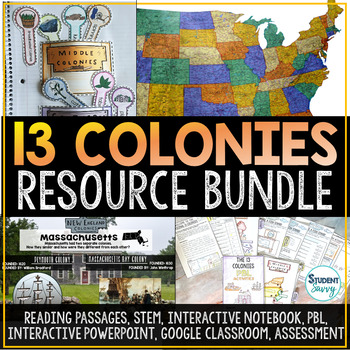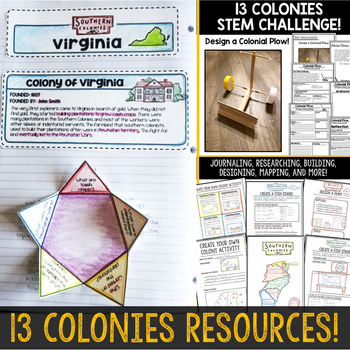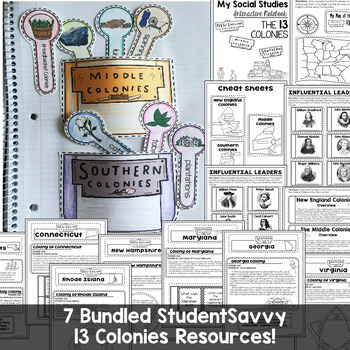13 Colonies Activities Reading Passages Projects Map Thirteen Colonial America
- Zip
- Easel Activity
What educators are saying
Products in this Bundle (7)
showing 1-5 of 7 products
Also included in
- This Upper Elementary and Middle School Complete US History Curriculum Resource has over 1,205 pages/slide of material covering Ancient American | Native Americans, The Age of Exploration, Relations Between Colonists and Native Americans, The Original 13 Colonies, Events Leading up to the RevolutionPrice $145.00Original Price $292.12Save $147.12
Description
13 Colonies Activities Resource Bundle!
This bundled product contains the following 7 StudentSavvy resources!
13 Colonies Interactive Notebook
13 Colonies Interactive PowerPoint
13 Colonies Google Classroom Student Projects
13 Colonies Assessments / Exam / Test
This resource is part of the US History Complete Curriculum
More information on each resource:
Interactive Notebook
Topics covered in this unit include:
The New England, Middle, and Southern Colonies, religious freedom vs religious tolerance, dissenters, Mayflower Compact, Quakers, Puritans, debtor’s prison, cash crops, blacksmiths, Frame of Government, plantations, Fundamental Orders of Connecticut, silversmiths, artisans, coopers, town criers, breadbasket colonies, indentured servants, proprietor, train, William Braford, John Winthrop, Thomas Hooker, John Manson, Roger Williams, John Berkeley, William Penn, Peter Minuit, John Smith, Cecil Calvert, Lord Proprietors, James Oglethorpe, and much more!
Reading Passages
Quick overview of topics covered in this resource include:
1.) The 13 Colonies: New England, Middle, and Southern Colonies
-The colonies were considered the first “13 States” of America (broad overview of the three types of colonies)
-Separated into three sections based on lifestyle (New England Colonies, The Middle Colonies, and The Southern Colonies)
-New England Colonies Overview: Colonists came for religious freedom, weather and terrain.
-Middle Colonies Overview: More diverse religions and cultures– Quakers, Lutherans, Dutch
Calvinists, and other religious groups
-Farming was much easier in the Middle Colonies
-Southern Colonies Overview: cash crops played a big role
-slaves and indentured servants were used as a workforce on plantations
-experienced outbreaks of malaria and yellow fever.
-bays, rivers, wetlands
Keywords: terrain, indentured servants, cash crop, whale oil, plantation, tobacco
2.) The New England Colonies (Massachusetts {Plymouth and Massachusetts Bay}, Connecticut, New Hampshire, Rhode Island)
-Plymouth Colony (Founder/Governor, year founded, Mayflower Compact overview
-Massachusetts Bay (Founder, “City upon a hill” (John Winthrop wanted this colony to set an example for the rest)
-Connecticut Colony (Thomas Hooker, year founded, – disagreed with Puritans, created the Fundamental Orders of Connecticut”, limiting government powers and it guaranteed more rights to individuals
-New Hampshire (year founded, founder, dominated by puritans – whales, fur, and fish were natural resources)
-Rhode Island (Year founded, founder) Roger Williams founded the colony but was later banished for spreading “dangerous opinions” – wanted separation of church and state
Keywords: Mayflower Compact, Fundamental Orders of Connecticut, Puritans, religious tolerance
3.) The Middle Colonies (New York, New Jersey, Pennsylvania, Delaware)
-New York Colony
Year founded, founded by Dutch Colonists
-describe climate and natural resources -no specific religion
-New Jersey Colony
-Year founded, founders
-first split into East and West, both had their own constitution set in place.
-Iron ore resource
-Pennsylvania Colony
-year founded, founder
-had religious tolerance, but mostly dominated by Quakers
-referred to as “holy experiment” colony by William Penn – wanted freedom of religion
-Delaware Colony
-year founded, founders
-founded because of rich soil, known as a breadbasket colony
-overview of how the ownership of this colony frequently changed
Keywords: Religious Freedom, Quakers, Breadbasket colony, William Penn
4.) The Southern Colonies (Virginia, Maryland, Georgia)
-Virginia Colony
1607, John Smith
-First searched for gold, then built plantations to grow cash crops (overview of plantations)
-Overview of Powhatan Wars (building plantations and taking over Powhatan territory)
-Maryland Colony
-foundation date, founded by
- -religious freedom for Catholics
-The Toleration Act (promised Christians could worship freely)
-plantations grew corn, fruit, cotton, and tobacco
-Georgia Colony
-foundation date, founded by
-Land given from King George II – where debtors seek refuge from the money they owed back in England – would be thrown in jail if you couldn’t earn the money back. The colony was used as a solution
-Slavery was (at first) not allowed, but later changed.
Keywords: Cash crops, plantations, Powhatan wars, The Toleration Act, debtors
5.) Southern Colonies Continued: (North and South Carolina)
North Carolina Colony
-foundation date, founded by
-overview of how The Carolinas were once a single colony but then separated into North and South.
-King Charles II gave the land to eight noblemen (the Lord Proprietors)
-the Lord Proprietors separated the colonies
South Carolina Colony
-foundation date, founded by
-Colonists first settled in Southern part – land was better for farming, more plantations developed. Slaves made up a large portion of population, they were the work force.
-Overview of what the plantations grew, overview of Atlantic slave trade, tobacco, cotton, cash crops
Interactive PowerPoint
This teaching resource is quite the virtual experience! This US History PowerPoint can be used as a powerful classroom presentation or students can click their way through it on individual computers.
***This product was created with PowerPoint (2016). The effects and transitions may not display properly on older versions.
PBL Activities
3 Colonies | PBL Activities | The Original Thirteen Colonies (Problem Based Learning | Project Based Learning)
Cross-curricular challenge for students who are studying US History
Welcome to the 13 Colonies!
You have traveled back in time to 1732, where Georgia, the last of the 13 colonies, has been established.
Students will create their very own PBL booklet. PBL activities utilize creative learning and real-world problem-solving strategies!
Students use mapping skills as well as knowledge of simple machines to build tools!
Sample pages (answer key) included in the file.
STEM Challenge
13 Colonies STEM Challenge | Design a Colonial Plow
Cross-curricular challenge for students who are studying US History and the original thirteen colonies!
This resource has science, technology, engineering, and ,math activities to do with your upper elementary kids that will really enhance their learning!
The STEM Challenge in this resource has detailed directions, photo examples, a list of materials needed, prediction section, brainstorming section, trials 1, 2, & 3, final results section with drawings, and a reflection section.
The STEM Challenge: Using the supplies below, students must engineer a model of a plow. The plow must have functioning wheels where the contraption can be pulled around while the wheels spin.... (more instructions in the download)
Google Classroom Student Projects
This product contains 3 digital projects that students can complete using Google Slides! This resource has a brochure project, a timeline project, and a info-graphic / poster project.
Each student-centered project has a sample project, answer key, and detailed project instructions for the students.
Assessment/Exam
This product contains an assessment that has vocabulary matching, fill in the blank, short answer, essay, and an info-graphic! It has 19 questions total.
It also contains an ANSWER KEY and an EDITABLE powerpoint file
Tips for Savvy TpT Shoppers:
How to receive credit on TpT to use for future purchases:
• Go to your My Purchases page. Under each purchase you'll see a Provide Feedback button. Simply click it and you will be taken to a page where you can give a quick rating and leave a short comment for the product. I value your feedback greatly as it helps me determine which products are most valuable for your classroom so I can create more for you.
Be the first to know about my new discounts, FREEBIES, and products:
• Look for a green star near the top of any page within my store and click it to become a follower. You will now be able to see FREEBIES and customized emails from my store!
©2020 StudentSavvy
All rights reserved by author. Permission to copy for single classroom use only. Electronic distribution limited to single classroom use only. (unless you purchase the multiple license)






